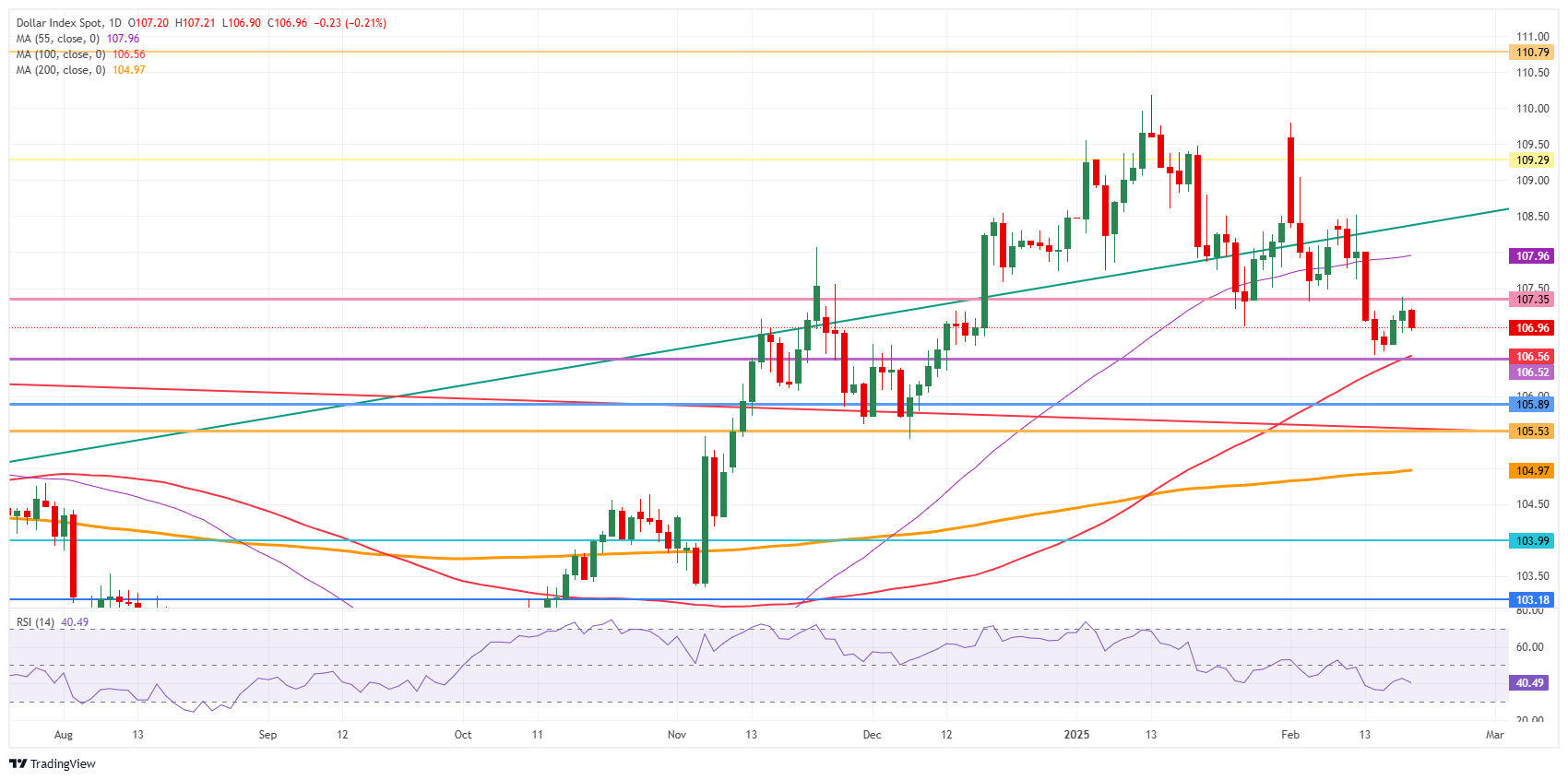US Dollar dips after President Trump says trade deal with China is possible
- The US Dollar edges lower against major currencies on a calm Thursday.
- US President Donald Trump lashed out at Ukraine and hinted at a possible trade deal with China.
- The US Dollar Index (DXY) reverses course and dips below 107.00 after a firm upside rejection on Wednesday.
The US Dollar Index (DXY), which tracks the performance of the US Dollar (USD) against six major currencies, slips lower on Thursday and trades below 107.00 at the time of writing. The move comes after United States (US) President Donald Trump mentioned that a trade deal with China might come. This is a big sigh of relief in markets on the tariff and trade front, as it would mean that some easing could come before April when levies are due to kick in.
The US economic calendar is quite calm this Thursday, except for the weekly Initial Jobless Claims, the Philadelphia Fed Manufacturing Survey for February and some speeches by Fed policymakers. However, as it happened in the earlier part of this week, US data is likely to be overshadowed by Trump’s comments.
Daily digest market movers: Does it matter?
- At 13:30 GMT, the weekly US Jobless Claims are due, with Initial Claims for the week ending February 14 expected to tick up to 215,000 from 213,000. Continuing Claims for the week ending February 7 are expected to head higher as well to 1.87 million, from the previous 1.85 million.
- At the same time, the Philadelphia Fed Manufacturing Survey for February is expected to decline to 20 from 44.3 in January.
- Quite an army of Fed speakers are scheduled for this Thursday:
- At 14:35 GMT, Chicago Fed President Austan Goolsbee speaks in a moderated Q&A at an event hosted by the Chicagoland Chamber of Commerce.
- At 17:05 GMT, St. Louis Fed President Alberto Musalem speaks to the Economic Club of New York about the US economy and monetary policy
- At 19:30 GMT, Fed Vice Chair for Supervision Michael Barr talks about supervision and regulation at an event at Georgetown University Law Center.
- Around 22:00 GMT, Federal Reserve Governor Adriana Kugler gives a speech on "Navigating inflation waves while riding on the Phillips curve" at a lecture hosted by Georgetown University.
- Equities are down across the globe, except for the European ones, with the German Dax and the pan-European Stoxx 50 in the green.
- The CME FedWatch tool shows a 51.2% chance that interest rates will remain unchanged at current levels in June.
- The US 10-year yield trades around 4.52%, slipping lower from its Wednesday’s high of 4.574%.
US Dollar Index Technical Analysis: Greenback just does not care
The US Dollar Index (DXY) is back to square one and gives up all its Wednesday’s gains. The firm technical rejection at 107.35 was enough to push the DXY back to where it was earlier this week. If US President Trump comes out with more easing or softening comments on tariffs or other deals, a revisit to 106.60 could be in the cards.
On the upside, the previous support at 107.35 has now turned into a firm resistance. Further up, the 55-day SMA at 107.96 must be regained before reclaiming 108.00.
On the downside, look for 106.56 (100-day SMA), 106.52 (April 16, 2024, high), or even 105.89 (resistance in June 2024) as support levels. The Relative Strength Index (RSI) momentum indicator in the daily chart shows room for more downside. Therefore, the 200-day SMA at 104.97 could be a possible outcome if a firm catalyst emerges.

US Dollar Index: Daily Chart
US Dollar FAQs
The US Dollar (USD) is the official currency of the United States of America, and the ‘de facto’ currency of a significant number of other countries where it is found in circulation alongside local notes. It is the most heavily traded currency in the world, accounting for over 88% of all global foreign exchange turnover, or an average of $6.6 trillion in transactions per day, according to data from 2022. Following the second world war, the USD took over from the British Pound as the world’s reserve currency. For most of its history, the US Dollar was backed by Gold, until the Bretton Woods Agreement in 1971 when the Gold Standard went away.
The most important single factor impacting on the value of the US Dollar is monetary policy, which is shaped by the Federal Reserve (Fed). The Fed has two mandates: to achieve price stability (control inflation) and foster full employment. Its primary tool to achieve these two goals is by adjusting interest rates. When prices are rising too quickly and inflation is above the Fed’s 2% target, the Fed will raise rates, which helps the USD value. When inflation falls below 2% or the Unemployment Rate is too high, the Fed may lower interest rates, which weighs on the Greenback.
In extreme situations, the Federal Reserve can also print more Dollars and enact quantitative easing (QE). QE is the process by which the Fed substantially increases the flow of credit in a stuck financial system. It is a non-standard policy measure used when credit has dried up because banks will not lend to each other (out of the fear of counterparty default). It is a last resort when simply lowering interest rates is unlikely to achieve the necessary result. It was the Fed’s weapon of choice to combat the credit crunch that occurred during the Great Financial Crisis in 2008. It involves the Fed printing more Dollars and using them to buy US government bonds predominantly from financial institutions. QE usually leads to a weaker US Dollar.
Quantitative tightening (QT) is the reverse process whereby the Federal Reserve stops buying bonds from financial institutions and does not reinvest the principal from the bonds it holds maturing in new purchases. It is usually positive for the US Dollar.

